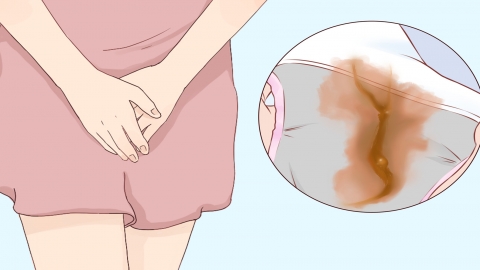What causes brown discharge during ovulation?
Generally, brown discharge during the ovulation period may be caused by factors such as fluctuations in estrogen levels, slight oxidation of blood from minor bleeding during ovulation, bacterial vaginosis, cervicitis, or endometrial polyps. It is recommended to seek timely medical attention, identify the underlying cause, and undergo symptomatic treatment under a doctor's guidance. Detailed explanations are as follows:

1. Fluctuations in estrogen levels: Estrogen levels rise before ovulation and briefly drop afterward, causing slight shedding of the endometrium. The blood mixes with secretions and oxidizes, turning brown. This is a normal physiological phenomenon that does not require special treatment. Rest well and maintain external genital hygiene.
2. Oxidation from minor bleeding during ovulation: Follicular rupture during ovulation may be accompanied by minimal bleeding. Blood remaining in the vagina for an extended period oxidizes and mixes with secretions, appearing brown. This typically lasts for 1-2 days. Maintain vaginal hygiene and avoid strenuous exercise.
3. Bacterial vaginosis: Caused by vaginal flora imbalance, bacterial infection leads to increased secretions that turn brown and emit a fishy odor. Patients may follow their doctor's advice to use medications such as metronidazole suppositories, clindamycin phosphate suppositories, or tinidazole suppositories for treatment.
4. Cervicitis: Often caused by infection with Chlamydia trachomatis or Neisseria gonorrhoeae, cervicitis leads to congestion and bleeding of the cervical mucosa, resulting in brown discharge accompanied by lower back pain. Patients should follow medical advice to take medications such as azithromycin capsules, doxycycline hydrochloride tablets, or cefixime dispersible tablets for treatment.
5. Endometrial polyps: Localized endometrial hyperplasia forms polyps, and rupture of blood vessels on the surface of the polyps causes bleeding that mixes with secretions, turning them brown and often accompanied by prolonged menstrual periods. Small polyps may simply be observed, while larger ones or those causing significant symptoms require hysteroscopic removal of the endometrial polyps to improve bleeding symptoms.
In daily life, maintain cleanliness and dryness of the genital area by washing the external genitalia with warm water daily and changing cotton underwear regularly. Avoid frequent use of feminine hygiene washes, which may disrupt the natural balance of vaginal flora. Maintain a regular sleep schedule, avoid excessive fatigue, and reduce factors that may cause abnormal discharge.




